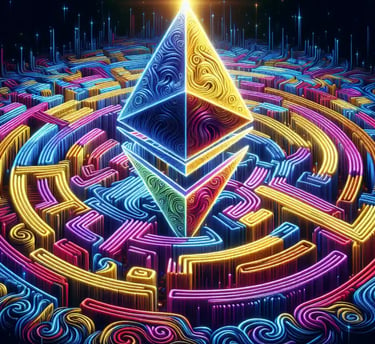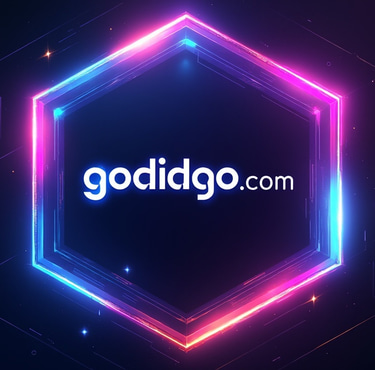Blockchain scalability and Layer 2 solutions
Addressing Ethereum’ scalability challenges
godidgo.com
11/8/20244 min read


As blockchain technology matures, scalability has emerged as one of its most significant hurdles, especially for major networks like Ethereum. Built for decentralized security and transparency, Ethereum’s network faces difficulties in processing a high volume of transactions efficiently, resulting in slow speeds and high fees during periods of congestion. The limitations are due to Ethereum's design, which prioritizes decentralization and security but sacrifices scalability. However, innovative Layer 2 solutions have been developed to address these challenges. This article examines Ethereum’s scalability issues and explores solutions like the Lightning Network and other Layer 2 approaches that are reshaping blockchain technology.
Understanding Blockchain scalability
Scalability in blockchain refers to a network's ability to handle a growing number of transactions without compromising performance. In a scalable blockchain, the infrastructure can increase throughput (transactions per second, or TPS) while maintaining security and low fees. Bitcoin and Ethereum, two of the most widely adopted blockchains, operate on decentralized consensus mechanisms that rely on validating each transaction across thousands of nodes. This commitment to decentralization means that scaling by simply adding more computing power (as seen in centralized systems) is not feasible.
Ethereum, for example, processes around 15-30 TPS on average, a number that lags far behind centralized payment processors like Visa, which can process thousands of TPS. During periods of high demand, Ethereum’s network can become congested, leading to high transaction fees and longer confirmation times.
Ethereum’s Scalability Challenges
Ethereum’s scalability limitations are largely rooted in its architecture. The platform relies on Proof of Work (PoW), a consensus mechanism where miners validate transactions by solving complex cryptographic puzzles. This method is secure and decentralized but inherently slow and resource-intensive. Although Ethereum is transitioning to Proof of Stake (PoS) with Ethereum 2.0 to improve efficiency, PoS alone does not fully resolve the scalability problem.
As decentralized applications (dApps), DeFi platforms, and NFT marketplaces have proliferated on Ethereum, the demand on its network has skyrocketed, revealing significant pain points:
Transaction Fees: Gas fees on Ethereum vary according to network congestion, but they can spike drastically during busy periods, making small transactions costly for users
Transaction Delays: When too many transactions flood the network, they are queued, leading to delays as miners prioritize transactions with higher fees
Network Efficiency: Ethereum’s design was built for security, not speed. As a result, the network struggles to meet the needs of a growing user base.
These issues have led to the development of Layer 2 solutions, which work alongside the main Ethereum network (Layer 1) to increase capacity, reduce fees, and improve transaction speeds.
What are Layer 2 solutions?
Layer 2 solutions are secondary frameworks built on top of the main blockchain. They aim to alleviate congestion on Layer 1 by processing transactions off-chain or within side networks, which reduces the load on the primary blockchain. Once transactions are finalized on Layer 2, they are bundled and recorded on the main chain, preserving security while improving efficiency.
Layer 2 solutions offer several advantages:
Increased Throughput: By handling transactions off the main chain, Layer 2 can significantly increase TPS
Reduced Fees: Processing transactions on a side chain or separate framework minimizes the costs associated with gas fees
Preserved Decentralization: Unlike scaling approaches that might require centralization, Layer 2 maintains Ethereum’s decentralized nature.
Key Layer 2 solutions: Optimistic Rollups, zk-Rollups, and state channels
Optimistic Rollups: Optimistic Rollups allow for transactions to be processed on a separate layer, then submit the transaction data back to the Ethereum mainnet. In this model, transaction data is stored on-chain, but computations occur off-chain, improving speed and reducing costs. Optimistic Rollups assume transactions are valid but incorporate a challenge period, allowing network participants to dispute any potential fraudulent activity. Popular implementations include projects like Optimism and Arbitrum, both of which are used extensively in the DeFi ecosystem.
zk-Rollups: Zero-Knowledge Rollups (zk-Rollups) work by grouping multiple transactions together, processing them off-chain, and then generating a cryptographic proof (known as a SNARK or STARK) to verify the transactions. This proof is then submitted to Ethereum’s mainnet. Unlike Optimistic Rollups, zk-Rollups do not require a challenge period because the proof verifies transaction validity. zk-Rollups are known for their speed and efficiency, making them a popular choice for projects focusing on privacy and speed, such as zkSync.
State Channels: State channels allow users to conduct multiple transactions off-chain without involving the main chain. In this approach, two parties open a payment channel and can interact freely off-chain. When they complete their transactions, the final state is recorded on Ethereum, preserving security while avoiding network congestion. This technique is especially useful for micropayments and gaming applications, where frequent, small transactions occur between participants.
The Lightning Network and Cross-Blockchain solutions
Originally developed for Bitcoin, the Lightning Network is a state channel solution aimed at facilitating faster, cheaper payments. Although it was built specifically for Bitcoin, the concept of state channels is used in Ethereum and other blockchains to improve scalability.
The Lightning Network allows participants to open direct channels where they can transact instantly off the main chain. When these users are ready, they can close the channel and update the main blockchain with the net transaction balance. This approach minimizes the load on Layer 1 and ensures that users avoid the long confirmation times and high fees associated with on-chain transactions.
The impact of Layer 2 on Ethereum’s future
Layer 2 solutions have become essential for Ethereum’s scalability roadmap, particularly as the platform aims to support mass adoption across multiple sectors, from finance to entertainment. By enabling faster transactions with lower fees, Layer 2 solutions facilitate the growth of dApps, DeFi, and NFT markets, which require high-frequency, cost-effective transactions.
Ethereum’s transition to Proof of Stake with Ethereum 2.0 will improve efficiency and reduce energy consumption, but Layer 2 solutions will continue to be crucial for enhancing scalability. The combined effect of PoS and Layer 2 is expected to create a more robust network capable of supporting global-scale applications.
The role of Layer 2 in the evolution of Blockchain
Blockchain scalability remains a key challenge as decentralized technology gains popularity. Layer 2 solutions like Optimistic Rollups, zk-Rollups, state channels, and the Lightning Network provide Ethereum and other blockchain networks with the tools needed to process transactions more efficiently without compromising decentralization. While Layer 1 improvements such as Ethereum’s PoS transition contribute to network efficiency, Layer 2 remains pivotal to supporting the vast potential of blockchain.
As developers and researchers continue to innovate, Layer 2 solutions will likely evolve, becoming integral to a blockchain ecosystem that can seamlessly handle millions of transactions per second. This convergence of Layer 1 and Layer 2 enhancements will help blockchain networks achieve the scalability necessary for global adoption, propelling Ethereum and blockchain technology into a new era of widespread, practical use.

Get in touch
Feel free to contact us to inquire about any of the DNS and Web3/Onchain domains showcased on our platform. We are open to receiving proposals and evaluating direct purchase offers for all the digital assets featured.
Our team is also available to explore tailored agreements and negotiated sales, ensuring a smooth and efficient acquisition process that aligns with your specific needs.
Connect with us to amplify your identity across both the DNS & Web3/Onchain landscape. Together, let's redefine the future of digital identities and brands.
Contact us now to elevate your DIDs & Brands to new heights, because in the world of Go DID Go! your Digital Identity is not just owned; it's celebrated!
Contact Us
info@godidgo.com




